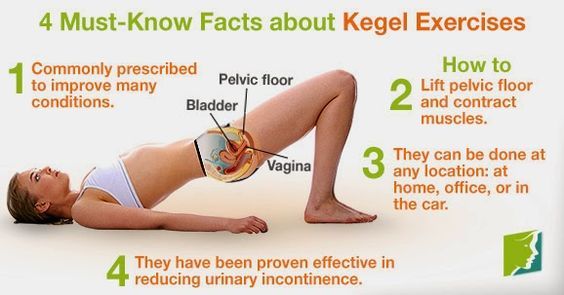Tighten pelvic floor
Pelvic floor exercises for women
The first step in performing pelvic floor muscle exercises is to identify the correct muscles.
How can I find my pelvic floor muscles?
Method 1 – Stopping the flow
There are several ways which may help you to correctly identify the different parts of your pelvic floor muscles. One way is to try to stop or slow the flow of urine midway through emptying the bladder. Stopping the flow of urine repeatedly on the toilet is not an exercise, but a way of identifying your pelvic floor muscles. This should only be done to identify which muscles are needed for bladder control.
If you can, stop the flow of urine over the toilet for a second or two, then relax and finish emptying without straining. This ‘stop-test’ may help you identify the muscles around the front passage which control the flow of urine. It is not recommended as a regular exercise.
Method 2 – Visualisation
Another method to identify your pelvic floor muscles is to imagine stopping the flow of urine and holding in flatus (wind) at the same time. This can be done lying down, sitting or standing with legs about shoulder width apart.
- Relax the muscles of your thighs, bottom and abdomen (tummy).
- Squeeze in the muscles around the front passage as if trying to stop the flow of urine.
- Squeeze in the muscles around the vagina and suck upwards inside the pelvic.
- Squeeze in the muscles around the back passage as if trying to stop passing wind.
- The muscles around the front and back passages should squeeze up and inside the pelvis.
- Women who are familiar with using tampons can imagine squeezing in the vagina as if squeezing a tampon up higher in the vagina.
- Identify the muscles that contract when you do all these things together. Then relax and loosen them.
Getting the technique right
This is the most important part of the pelvic floor muscle exercises as there is no point doing them if you are not doing them correctly.
Imagine letting go like you would to pass urine or to pass wind. Let your tummy muscles hang loose too. See if you can squeeze in and hold the muscles inside the pelvis while you breathe. Nothing above the belly button should tighten or tense. Some tensing and flattening of the lower part of the tummy wall will happen. This is not a problem, as this part of the tummy works together with the pelvic floor muscles.
Let your tummy muscles hang loose too. See if you can squeeze in and hold the muscles inside the pelvis while you breathe. Nothing above the belly button should tighten or tense. Some tensing and flattening of the lower part of the tummy wall will happen. This is not a problem, as this part of the tummy works together with the pelvic floor muscles.
Try tightening your muscles really gently to feel just the pelvic floor muscles lifting and squeezing in. If you cannot feel your muscles contracting, change your position and try again. For example, if you cannot feel your muscles contracting in a seated position, try lying down or standing up instead.
After a contraction it is important to relax the muscles. This will allow your muscles to recover from the previous contraction and prepare for the next contraction.
It is common to try too hard and have too many outside muscles tighten. This is an internal exercise and correct technique is vital. Doing pelvic floor muscle exercises the wrong way can be bad for you, so please see a health professional if you cannot feel your muscles hold or relax.
Exercising your pelvic floor muscles
Once you have mastered the art of contracting your pelvic floor muscles correctly, you can try holding the inward squeeze for longer (up to 10 seconds) before relaxing. Make sure you can breathe easily while you squeeze.
If you can do this exercise, repeat it up to 10 times, but only as long as you can do it with perfect technique while breathing quietly and keeping everything above the belly button relaxed. This can be done more often during the day to improve control.
Useful resources for exercising pelvic floor muscles:
- Pelvic Floor Muscle Training for Women
- Pelvic Floor Muscle Exercises for Women (for Aboriginal and Torres Strait Islanders)
- Pelvic Floor Muscle Exercises (Easy English)
When to seek professional help
Seek professional help when you have bladder or bowel control problems with symptoms such as:
- needing to urgently or frequently go to the toilet to pass urine or bowel motions
- accidental leakage of urine, bowel motions or wind
- difficulty emptying your bladder or bowel
- vaginal heaviness or a bulge
- pain in the bladder, bowel or in your back near the pelvic floor area when exercising the pelvic floor or during intercourse
These problems may not necessarily be linked to weak pelvic floor muscles and should be properly assessed.
Like all exercises, pelvic floor exercises are most effective when individually tailored and monitored. The exercises described are only a guide and may not help if done incorrectly or if the training is inappropriate.
Incontinence can have many causes and should be individually assessed before starting a pelvic floor muscle training program. Tightening or strengthening pelvic floor muscles may not be the most appropriate treatment so speak to a health professional if you have persistent problems with your bladder or bowel. Visit the Resources page for more information.
Health professionals
Continence and women’s health or pelvic floor physiotherapists specialise in pelvic floor muscle exercises. They can assess your pelvic floor function and tailor an exercise program to meet your specific needs. They can also prescribe other treatment options such as biofeedback and discuss relevant lifestyle factors with you.
For a list of continence and women’s health or pelvic floor physiotherapists, search the Continence Foundation of Australia’s service provider directory or call the National Continence Helpline on 1800 33 00 66.
You may also like to see:
- Video: Learn how to do pelvic floor muscle exercises
Female Pelvic Medicine and Reconstructive Surgery
5 Ways To Strengthen Your Pelvic Floor: The Woman’s Center : Female Pelvic Medicine and Reconstructive SurgeryThere’s one very important muscle that most gym trainers don’t mention: Your pelvic floor.
Like any muscle group, your pelvic floor requires routine exercise to stay strong and function properly. And for women, the pelvic floor serves a pretty important function: It’s the sheet of muscle that supports the bladder, uterus, and bowel.
To keep your pelvic floor functioning properly — and to prevent everything from injury, such as pelvic organ prolapse, to involuntary bladder or bowel leakage — here are five ways to keep this key muscle group strong and healthy.
Kegels — done right
Whether you’ve been performing Kegel exercises for a while or have never tried at all, it’s important to make sure you’re engaging the right muscles while doing this exercise.
To do this correctly, try sitting comfortably with your knees and feet spread apart, leaning forward, with your elbows resting on your knees. Breathe regularly and relax your stomach, leg, and buttock muscles.
Imagine you’re trying to stop yourself from passing gas at the same time trying to stop urinating midstream. This should result in a tightening sensation around your vagina and anus. Hold that position for a few seconds, then release, and voila: That’s one successful Kegel!
We recommend aiming for three daily sets of 8-12 contractions. If you don’t have much experience performing Kegels, it’s OK to start with 4-5 contracts per daily set. Here’s an in-depth guide on how to ensure you’re performing Kegels correctly.
Maintaining a healthy weight
Excess weight can place extreme pressure on the organs contained by the pelvic floor. If you’re overweight or lead a sedentary lifestyle, you may be at risk for incontinence or pelvic organ prolapse.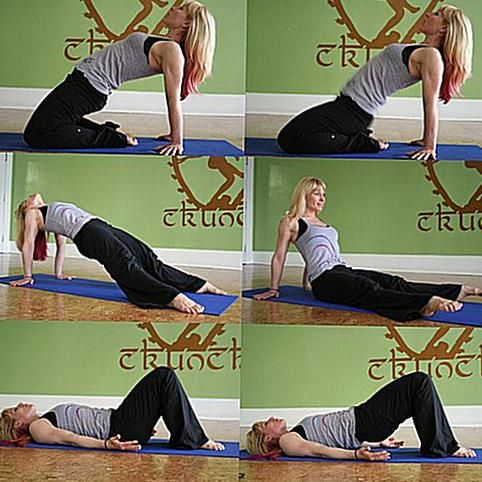
Dietary changes in addition to regular exercise are simple yet long-term steps anyone can take to ensure pelvic floor health.
Yoga
While Kegels target a specific area, it’s important to remember that the pelvic floor is part of a larger muscle group that holds the pelvic organs in place. The diaphragm, abdominals, and obliques are also connected to pelvic health, so keeping those muscles active is vital to preventing pelvic organ prolapse or incontinence.
That’s where yoga comes in: Prevention Magazine reports that women in one study saw a 70% decrease in their incontinence frequency after a 6-week yoga therapy program. Prevention also broke down the four most effective yoga poses for pelvic floor health: Malasana, Reclined Bound Angle, Legs Up the Wall, and everyone’s favorite, Child’s Pose.
Lower ab and core exercises
Once you’ve mastered Kegels, you can move on to more challenging exercises that engage your pelvic floor muscles.
Three essential pelvic-floor-friendly moves include:
Bridge. Lie on your back with your knees bent and hip-width apart. Inhale, flex your pelvic floor muscles, and lift your hips. Hold for 10 seconds, and do 10 reps.
Wall Squat. Stand against a wall with your feet hip-width apart. Inhale, flex your pelvic floor muscles, and lower your body as if you’re sitting in a chair. Hold for 10 seconds, stand up straight again, and release your pelvic muscles. Repeat for 10 reps.
Jumping Jacks. A gym-class classic. Flex your pelvic floor muscles as you jump with your legs apart, and release them as you hop your legs back together. Repeat for 30 to 60 seconds.
Biofeedback
If you’ve tried Kegels and other exercises, yet still struggle to find and isolate your pelvic muscles, biofeedback therapy is a safe, effective method for increasing pelvic muscle strength.
Biofeedback therapy involves biofeedback instruments, from small sensors to stickers placed inside or just outside the vagina and anus, that measure muscle activity and detect contractions of the pelvic floor.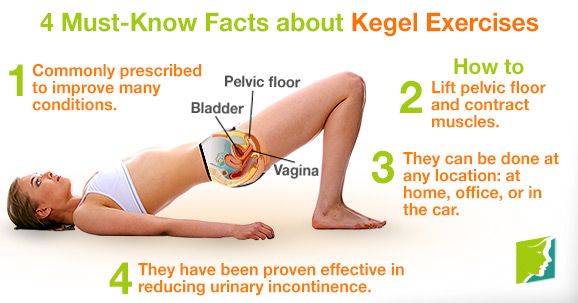 This can help reverse the most common error women make while performing Kegels, which is engaging the abdominal muscles rather than the pelvic floor muscles.
This can help reverse the most common error women make while performing Kegels, which is engaging the abdominal muscles rather than the pelvic floor muscles.
When provided by a biofeedback therapist, such as those in residence at The Woman’s Center for Advanced Pelvic Surgery, biofeedback is proven to help women who struggle with accidental bladder and bowel leakage regain pelvic floor strength. Contact us if you or someone you love could benefit from physical therapy for better pelvic floor health.
Dr. Ryan Stratford is board-certified in Female Pelvic Medicine and Reconstructive Surgery (FPMRS) as well as Obstetrics and Gynecology (Ob/Gyn) with a wealth of clinical and research experience. Learn More about Dr. Stratford
Kegel Exercises: Benefits, Instructions, and Helpful Tips
Pelvic floor exercises, also called Kegel (kay-gull) exercises after Dr. Arnold Kegel who developed them, strengthen the pelvic floor muscles. These muscles play a role in supporting the bladder ad urethra.
These muscles play a role in supporting the bladder ad urethra.
Treatment Options For Overactive Bladder (OAB)
Is your daily schedule controlled by your bladder? Do you know where every single bathroom is within a 20-mile radius of your home? If you answered yes to either of these questions, you may have symptoms of overactive bladder (OAB).
Pelvic floor exercises (Kegel exercises) for men
ShareTime to read: Approximately 2 min.
This information will help you learn how to do pelvic floor exercises (Kegel exercises).
back to top of pageAbout Kegel Exercises
The main purpose of Kegel exercises is to help you strengthen your pelvic floor muscles. These muscles support your bladder and intestines. nine0011
With Kegel exercises you can:
- Control or prevent urinary incontinence.
 Incontinence is the leakage of urine and stool (feces) that you cannot control.
Incontinence is the leakage of urine and stool (feces) that you cannot control. - strengthen your sexual health.
About the pelvic floor muscles
The pelvic floor muscles line the pelvic cavity and support the pelvic organs (see figure 1). These are the muscles that relax during urination (when you go to the toilet in a small way) and during passing gases or bowel movements (when you go to the toilet in a big way). You also use these muscles to hold urine and prevent leakage. nine0011
Figure 1 Pelvic floor muscles
Pelvic Floor Muscle Test
Pelvic floor muscle test must be done before performing Kegel exercises. Think about what muscles you use to interrupt the stream of urine when urinating, concentrate on them. Do not do this often, as stopping the flow of urine every time you urinate can be harmful.
back to top of pageHow to Do Kegel Exercises
Make sure you urinate to keep your bladder empty before beginning Kegel exercises. nine0011
nine0011
When you're ready, start doing the following:
- To begin, pull in your pelvic floor muscles and hold for 5 seconds. To do this, imagine that you are pulling in and lifting the genitals.
- Do not hold your breath. Counting out loud will keep you from holding your breath.
- After 5 seconds, slowly and completely relax the muscles, holding them in this state for 5 seconds.
- Repeat the exercise 10 times and do it at least 3 times daily. nine0004
Your pelvic floor muscles may become tired during this exercise. In this case, stop doing the exercise and start it later.
This exercise does not involve the abdominal muscles, legs or buttocks. Exercising these muscles will not help you regain urinary control or improve your sexual health.
As you continue with these exercises, gradually increase the amount of time the pelvic floor muscles are contracted and relaxed. Start with 5 seconds and gradually build up the time each week until you reach 10 seconds.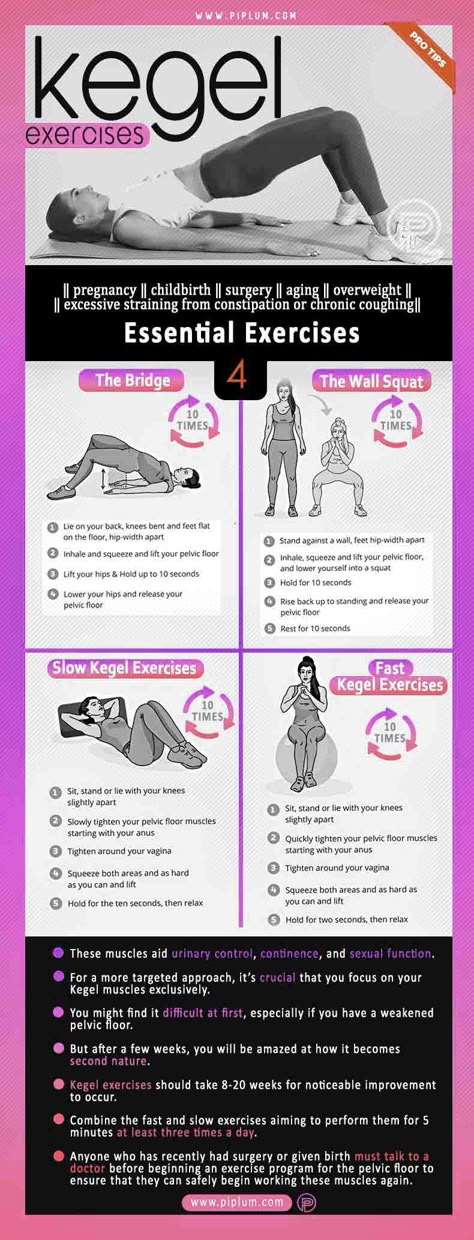 nine0011 back to top of page
nine0011 back to top of page
When to do Kegel exercises
Most people prefer to do Kegel exercises while lying in bed or sitting in a chair. They can be done in any position convenient for you. Doing Kegel exercises while standing can be very helpful, as urine leakage usually occurs in this position.
To prevent leakage of urine, try a Kegel exercise before you:
- stand up;
- walk; nine0004
- go to the toilet;
- to sneeze or cough;
- laugh.
Doing these exercises will help you strengthen your pelvic floor muscles and reduce urine leakage.
Do not do Kegel exercises if you have a Foley catheter (thin, flexible tube) in place.
Pain and Kegel exercises
Kegel exercises should not cause pain. Many find them simple and relaxing. But if you use the wrong muscles when doing them, you may experience discomfort. nine0011
- If you experience pain in your back or abdomen after doing Kegel exercises, you may be using your abdominal or back muscles instead of your pelvic floor muscles.
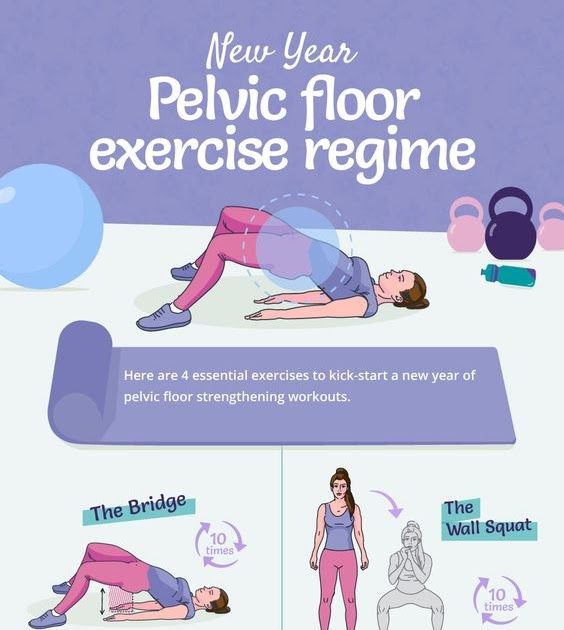
- If you have a headache after doing Kegel exercises, you may be tightening your chest muscles and holding your breath.
When should you contact your healthcare provider?
Call your healthcare provider if:
- concerns about bowel, bladder, or sexual function;
- difficulty concentrating on pelvic floor muscles;
- pain when doing Kegel exercises;
- difficulty doing Kegel exercises;
- pelvic pain;
- questions requiring referral to a pelvic physiotherapist.
You must have JavaScript enabled to use this form. nine0011
Share your opinion
Give us your feedback
Your feedback will help us improve the information we provide to patients and caregivers.
Questions
| Questions | Yes | To some extent | No |
|---|---|---|---|
| Was this information easy for you to understand? | Yes | To some extent | No |
What should be explained in more detail?
Women's Pelvic Floor Strengthening Exercises
This fact sheet has been compiled to educate patients about pelvic floor strengthening exercises.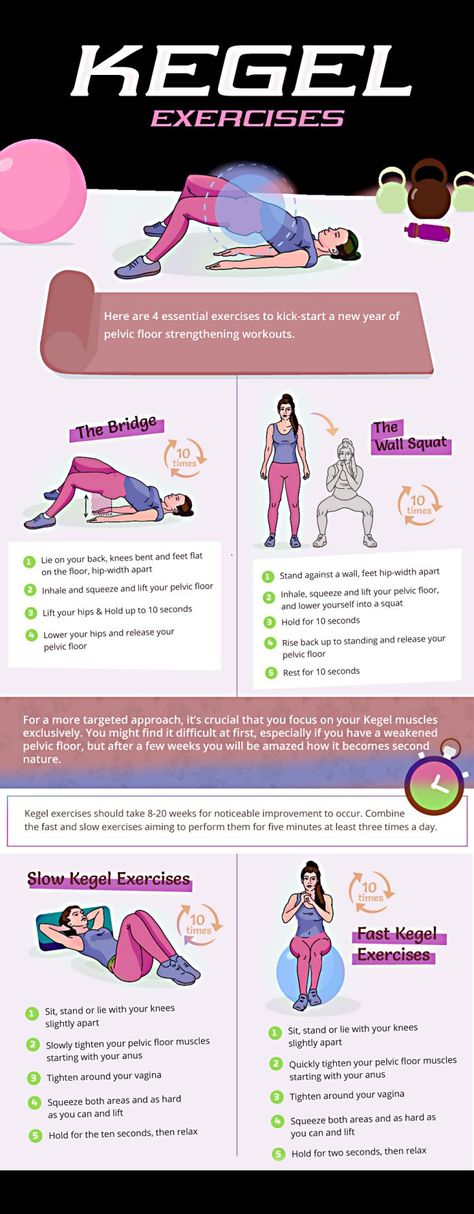
More than 50% of women who have given birth have problems with urination, and at an older age, prolapse of the uterus (prolapse), which can be caused by weakness of the pelvic floor muscles. nine0011
Strong pelvic floor muscles help improve bladder and sexual function, as well as keep internal organs in a normal anatomical position. Pelvic floor muscle problems can be caused by pregnancy, childbirth, chronic constipation, being overweight, smoking, menopause, and neurological problems.
Symptoms of pelvic floor weakness may include incontinence when coughing and sneezing, frequent urination and need to urinate at night, vaginal pain, pain during sex. nine0011
To prevent and alleviate urinary incontinence and organ prolapse, it is very important to learn how to contract the pelvic floor muscles correctly.
The pelvic floor muscles are located in the pelvic floor area between the pubic bone and the coccyx. Their function is to maintain the correct position of the organs (uterus, bladder, intestines) inside the pelvis, as well as to keep the urethra and anus closed to prevent involuntary leakage of contents, and to relax them during emptying.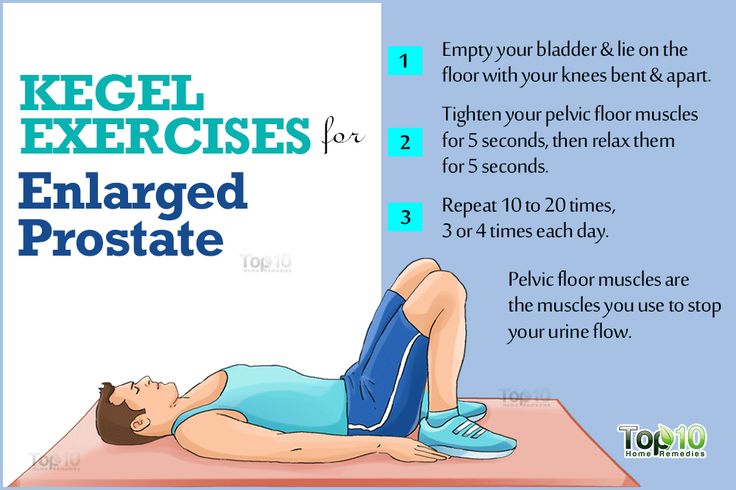 nine0011
nine0011
Like all other muscles in the body, the pelvic floor muscles also need special training.
Manual
Get into a comfortable sitting or lying position. Try to tighten your pelvic floor muscles as if you are trying to interrupt the flow of urine or intestinal gases by pulling the muscles up.
You may feel tension when the muscles contract. Do not hold your breath, take a deep breath through your nose and slowly exhale through your mouth. At the same time, the abdominal muscles can also tense up, this is normal. nine0011
Try to keep the muscles of the buttocks and legs relaxed. After each contraction of the pelvic floor muscles, try to completely relax these muscles.
Three basic ways to control the correct contraction of the pelvic floor muscles:
- Observe the perineum through a mirror and tighten the pelvic floor muscles. Watch to see if the vagina moves inward in the opposite direction from the mirror.
 If you see the movement of the vagina towards the mirror, stop immediately and seek help from a physical therapist who specializes in training the muscles of the pelvic floor. nine0004
If you see the movement of the vagina towards the mirror, stop immediately and seek help from a physical therapist who specializes in training the muscles of the pelvic floor. nine0004 - Place your thumb or index finger into your vagina. As your pelvic floor muscles contract, you should feel your vagina tighten around your finger.
- Contract your pelvic floor muscles during sex, asking your partner if they feel pressure.
How to Do Pelvic Floor Exercises
- Contract your pelvic floor muscles and try to hold that contraction for a count of seconds, and then relax those muscles for the same number of seconds. For how many seconds can you maintain muscle tension? How many reps can you do? nine0004
- Alternately contract the pelvic floor muscles for 1 second and then relax them also for 1 second. How many of these short repetitions can you do before you feel tired in the muscles? Always relax your pelvic floor muscles before each new contraction.
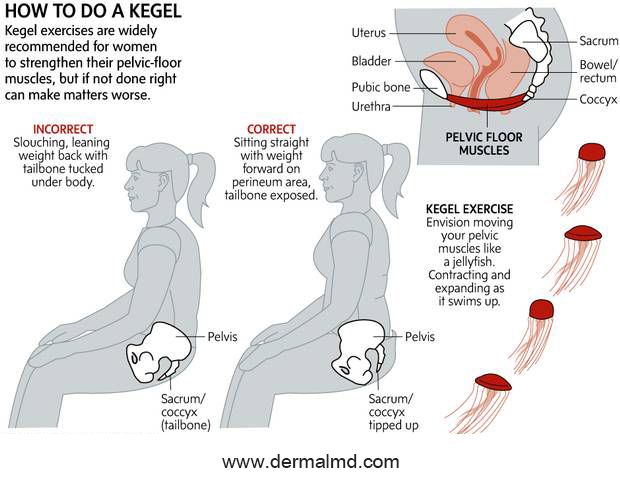
Your goal is to do 10 long contractions while holding the muscle tension for 10 seconds; each contraction should be alternated with a 10 second relaxation. Then do 10 short contractions; each contraction should alternate with a short relaxation. nine0082
You can start with a shorter duration and fewer repetitions. Do exercises at least 3 times a day. At first, the exercises are easier to perform in a sitting or lying position. You should feel the results in 3-5 months. Subsequently, to maintain the result of the exercise, you can do it once a day. As your muscles strengthen, try doing the exercises in other positions as well (for example, lying on your side, with emphasis on your knees, standing, while moving). nine0011
Try to tense your pelvic floor muscles before coughing, sneezing, lifting weights, laughing.
Avoid carbonated or caffeinated drinks to prevent constipation. Drink at least 1.5 liters of water per day. When you have a bowel movement, place your feet on a small footrest to squat as if (this makes it easier to have a bowel movement).